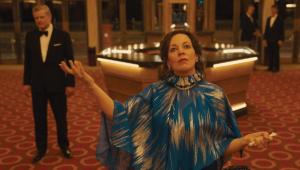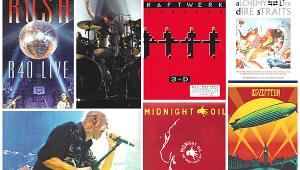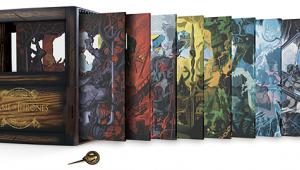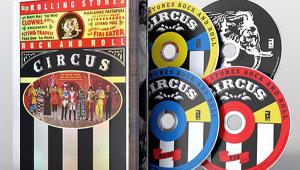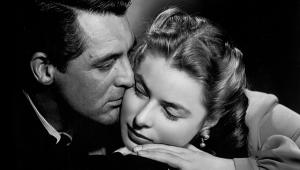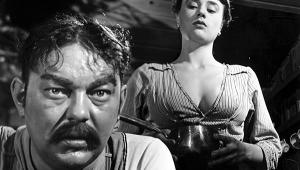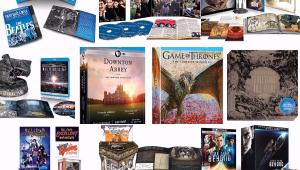Schindler's List & Broken Silence
Schindler's List
Liam Neeson, Ben Kingsley, Ralph Fiennes, Caroline Goodall, Jonathan Sagalle, Embeth Davidtz. Directed by Steven Spielberg. Aspect ratio: 1.85:1 (anamorphic). Dolby Digital 5.1, DTS. 196 minutes. 1993. Universal Home Video 23866. R. $26.98.
Picture ****
Sound ****
Film ****
Broken Silence
Some Who Lived: directed by Luis Puenzo. Eyes of the Holocaust: directed by János Szasz. Children from the Abyss: directed by Pavel Chukhraj. I Remember: directed by Andrzej Wajda. Hell On Earth: directed by Vojtech Jasny. Aspect ratio: 4:3. Dolby Digital 5.1, Dolby Surround (Spanish, Hungarian, Russian, Polish, or Czech, all with English subtitles). 283 minutes. 2002. Universal Home Video 24700. NR. $26.98.
Picture ***
Sound ***
Film ****
Even a decade after its theatrical release, re-experiencing the multiple Oscar-winner Schindler's List, this time on DVD, is nothing short of devastating. I was stunned when I first watched Steven Spielberg's monumental masterpiece: the unsparing, step-by-step depiction of the extermination of most of the Jews of Krakow, Poland, by the diabolical Nazi machine. This time around, I found myself once again defenseless against the horrors portrayed in the film, which was based on Thomas Keneally's novel. It was especially harrowing when combined with Broken Silence, a compilation of five documentaries by notable international directors, featuring heartbreaking interviews with Holocaust survivors.
 My first viewing of Schindler's List was slightly tempered by my belief that a film about the subject shouldn't have a German, or any non-Jew, at its center. American movies have traditionally used an American, or an erudite European, as a hook to introduce audiences to foreign lands and subjects (for example, Eva Marie Saint in Exodus). But the story of Oskar Schindler (Liam Neeson), a German bon vivant who saw an opportunity to make millions out of Jewish investors and laborers who were shut out of the market, is neither hook nor gimmick. There's something transcendental in this story of morality and virtue.
My first viewing of Schindler's List was slightly tempered by my belief that a film about the subject shouldn't have a German, or any non-Jew, at its center. American movies have traditionally used an American, or an erudite European, as a hook to introduce audiences to foreign lands and subjects (for example, Eva Marie Saint in Exodus). But the story of Oskar Schindler (Liam Neeson), a German bon vivant who saw an opportunity to make millions out of Jewish investors and laborers who were shut out of the market, is neither hook nor gimmick. There's something transcendental in this story of morality and virtue.
At first, Schindler sees nothing wrong in benefiting from the labor of the men, women, and children on his list of workers, in exchange for feeding them and protecting them from persecution. But gradually, like an Everyman who rises to the grand task that destiny has put on his shoulders, Schindler begins to care—and not just out of gratitude to accountant Itzhak Stern (Ben Kingsley), the mastermind behind his business empire.
Although Schindler is a member of the Nazi Party, he's doesn't share Hitler's ideology. He begins to see his employees as human beings, develops a fierce loyalty to them, and doesn't shy away from confronting high party officials on their behalf. In one pivotal sequence, Schindler travels to Auschwitz, where a train full of his women and children workers has been sent even though he's already paid a high price to keep them in his employ.
We get glimpses of the individual tragedies and fates of Spielberg's numerous Jewish characters. Each is a piece of the mosaic of the Holocaust, a microcosm multiplied six million times. These individuals are systematically brutalized and stripped of their humanity before they are shot or gassed. The Nazis' plan of first confiscating their property, then locking them up in ghettos with little food, then transporting them like cattle to "labor" camps, where the "Final Solution" awaited them, is unveiled by Spielberg without embellishment—the horror is such that there is no need to manufacture drama or inject sentimentality.
Schindler's List is a chance to look into the soul of one good German, in contrast with the demented barbarity of a Nazi officer, Amon Goeth (Ralph Fiennes), who revels in his own sadism and proudly declares Krakow to be "free of Jews." When Schindler tries to convince him that a true sense of power comes not from harming the defenseless but from refraining from the impulse to abuse power, Goeth tries it briefly, but gets no satisfaction.
The confusion into which the Jews are thrown, and their refusal to believe that anything so vile could be perpetrated by the soldiers of a civilized nation such as Germany, is understandable. They are shocked by the joy with which their neighbors greet their misfortune and inform on those who manage to hide.
 The beautiful, never obtrusive camera work by Janusz Kaminski uses black and white to depict the horrific reality with haunting starkness. It resorts to snippets of color when a ray of hope manages to break through: the opening prayer sequence with lit candles, the pink coat of a little girl, and the aftermath, with the present-day survivors of Schindler's list reverently visiting his grave in Israel.
The beautiful, never obtrusive camera work by Janusz Kaminski uses black and white to depict the horrific reality with haunting starkness. It resorts to snippets of color when a ray of hope manages to break through: the opening prayer sequence with lit candles, the pink coat of a little girl, and the aftermath, with the present-day survivors of Schindler's list reverently visiting his grave in Israel.
Broken Silence adds a perspective that is at once broader, pan-European, and more intimate—a series of first-person accounts by survivors. The subtitles both preserve authenticity and unintentionally allow the viewer a certain respite from the emotionally overwhelming content. In Eyes of the Holocaust, filmmaker János Szasz reconstructs the lost universe of Hungarian Jewry through a mix of oral testimonies of survivors who were children during the Holocaust and documentary footage and dramatizations. Russian filmmaker Pavel Chukhraj's Children from the Abyss gives Holocaust survivors an opportunity to talk about their contributions to the resistance, and the betrayals and collaborators they encountered. This segment is closest to a narrative story, and its pathos and lyricism are especially moving.
In Andrzej Wajda's I Remember, four survivors recall how they were either helped or betrayed by their Polish neighbors. Vojtech Jasny's Hell on Earth examines life in Theresienstadt, the fake "City for the Jews" created in Czechoslovakia by the SS to deceive the Red Cross and the world about how the Jews were living in model settlements. And in Luis Puenzo's Some Who Loved, Latin American Jews remember their suffering in Europe during the Nazi era. Individual moments of anguish will haunt you for a long time—such as the old man who still denies he's Jewish because he can't free himself from his fear of the past. Or the recollection of a woman who evaded execution by applying her own blood to her face in order to hide a sickly appearance under a rosy complexion. Most heartbreaking are the tearful memories from almost every survivor about the last time they saw their parents alive.
Schindler's List and Broken Silence are all the more shattering thanks to their excellent transfers, in which the clarity of the images, the extreme attention to detail and nuance, only enhance the horror. There isn't a glitch or a scratch on the pristine dual-layer transfer of Schindler. The shades of gray are rich, and the color, in select sequences, is properly subdued. Spielberg used the 1.85:1 aspect ratio to effect, combining spectacle (if that is the word) and intimacy. The 5.1-channel sound, both Dolby Digital and DTS, is multileveled and robust. Truly exceptional.
Even the archival footage of Broken Silence has been cleaned up as much as possible. Both image and sound (Dolby Digital 5.1 and Dolby Surround) are solid. Both DVDs are absolute musts.—DY
- Log in or register to post comments
